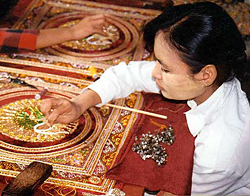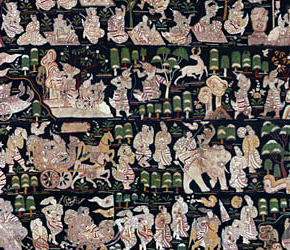In Mandalay, An Artist Keeps Vanishing Worlds Alive
By Stephen Brookes in Mandalay
for Asia Times
On a quiet street on the eastern edge of Mandalay, a world away from the city's chaotic commercial center, tapestry artist Sein Myint is creating a small, strange universe of his own. As his chalk moves quickly over the canvas, sacred dragons and winged elephants appear, dancing girls cavort in gardens, and celestial beings beam down benignly from the clouds. 
Tony Wright
As he sketches, dozens of young women around him are busily working on several other large tapestries, sewing sequins onto velvet and untangling long coils of gold and silver thread, ready to complete his designs and bring them to life. For Sein Myint has emerged as the acknowledged master of an ancient and almost-vanished art -- the ornate, embroidered and uniquely Myanmar tapestries known as kalaga.
"Every one of these tapestries tells a story," said the 51-year-old artist, getting up from the two-meter stretch of cloth he's been drawing on. "Some are from mythology, others are tales from the Ramayana," he added, referring to the Buddhist epic. "We're trying to keep those traditions alive, but also modernize them."
To a large extent, Sein Myint has been the central figure in reviving the dying art of the kalaga, also known as shwe gyi do -- "golden thread sewing.” His Mandalay workshop produces between 400 and 500 tapestries a year, which make their way to monasteries, museums and private collectors around the world. "We don't make any of the commercial products," he said with a grimace, referring to the kalaga baseball caps and handbags sold in local souvenir shops. "We're committed to making beautiful tapestries."
The art of the kalaga was born in the mid-1700's during the reign of King Alaungpaya, when tailors began sewing gold coins onto rough-spun cotton cloth as decoration. Under Thai and European influences the techniques became more refined and intricate, and by the end of the 19th century kalaga artists -- working, like Sein Myint, in family workshops in Mandalay -- were importing materials from all over the world and expanding their palette of techniques.
The tapestries were used initially as wall hangings in monasteries and palaces, but gradually moved into all areas of life -- to screen off rooms and cover doorways, decorate bullock carts, and even as coffin covers. (One especially elaborate one, reserved for royalty, can be seen in the National Museum in Yangon.) Marionettes -- another Myanmar traditional art -- were clothed in kalaga costumes, and their stage sets were tapestries as well.
The kalagas continued to develop in complexity until World War Two, with padded figures and new materials being incorporated into the designs. But during Myanmar's socialist period from 1962 to 1988, when the country was virtually cut off from the outside world, the art nearly died. As the economy disintegrated, only a few workshops managed to survive. 
19th Century KalagaSein Myint, meanwhile, had taken an interest in the art. Growing up in Mandalay, he showed signs of being a renegade even as a child. Paw Oo Thett, one of the country's foremost artists, was his uncle, and Sein Myint would copy the older man's paintings -- to the point where the young artist was finishing copies of his uncle's paintings even before Paw Oo Thett could complete the originals.
And his life after that was equally aggressive. He continued to paint, producing increasingly abstract watercolors, but went into business to make a living. He's vague about exactly what he did, saying only that for fifteen years was "successful in trading", but acquaintances claim he made his fortune in bootleg Mandalay Rum. "His moonshine was more popular than the real thing," said one friend. But it may have been a rough business. "You noticed that his left eye is glass?" added the friend. "He lost it in a fight, years ago."
Sein Myint's successful "trading" allowed him to continue painting, and to start designing and producing the kalaga tapestries. During the 1980's his fame spread, and 1989, his stature as the country's premier kalaga artist was recognized when he was commissioned to make a huge, six-meter tapestry for the United Nations. Depicting Lokanat -- the Myanmar god of peace -- presiding over a landscape of pagodas, rice fields and forests of teak, it now hangs in the UN Security Council headquarters in New York.
In fact, his reputation as an artist has spread internationally, with shows of his kalagas and watercolors in Switzerland, Japan, Sri Lanka and the United States. And many of his paintings are remarkably sophisticated, in a country with a weak painting tradition. Many are stylized Myanmar scenes, charming enough to be reproduced as Unicef greeting cards. But others show a furious intensity and a strong, adventurous approach to color and form; a few even look as if they might have been done by the abstract expressionists Franz Kline or Robert Motherwell.
Aside from watching his famous uncle work, Sein Myint says he had no formal training in art at all. "I'm like a village hunter, rather than a professional sniper", he said. "A sniper is well-trained, and he knows how to hit the target. The village hunter has to rely on his heart -- but he can still shoot straight."
There's another side to Sein Myint, as well: Over the past thirty years, he has assembled what many say is the finest private collection of Myanmar art and handicrafts in the country. Encompassing everything from 2,000-year-old pots to fading 19th-century tapestries to elegantly carved bows from the hills of the Shan States, the collection is a Mecca for connoisseurs of Myanmar culture.
"Everything here is related, in some way, to the tapestries," he said, guiding a visitor through the large, open rooms of his home, where elegant pieces of antique lacquerware sit side-by-side with beautifully grotesque sculptures of ogres. An old bellows with an elephant-head snout -- his most recent acquisition -- is displayed proudly on an intricately carved teak table.
"Look at this painting, for example," he said, nodding toward a family portrait of a young prince in the Mandalay Court, surrounded by several of his wives and servants. "It was painted by Saya Chone in the late 19th century, and shows very clearly how the clothes were worn and what the patterns were. So I can be accurate in the way I portray the figures in the kalagas."
And while most of the objects were collected in Myanmar, some of the best pieces had to be brought back from London, where British collectors took them during the colonial period.
"These were bought at Sotheby's a few years ago," he said, of a set of three highly detailed paintings on silk from the mid-19th century reign of King Mindon -- probably the only such paintings still in the country. The paintings show a "skill competition" among the royal elephants -- a glimpse into the long-vanished world of the Mandalay Court.
Sein Myint plans to open his home as what he calls a "salon" in the near future, to allow visitors a chance to see Myanmar culture at its best.
"I'm not a millionaire -- I can only collect a few things," he said. "But it's important that we keep these aspects of our culture here, and not let them be sold off to foreign collectors. Because now, the old traditions are being revived," he added. "People can not only create now, but they can make a living at it. This is a big step forward for us."

